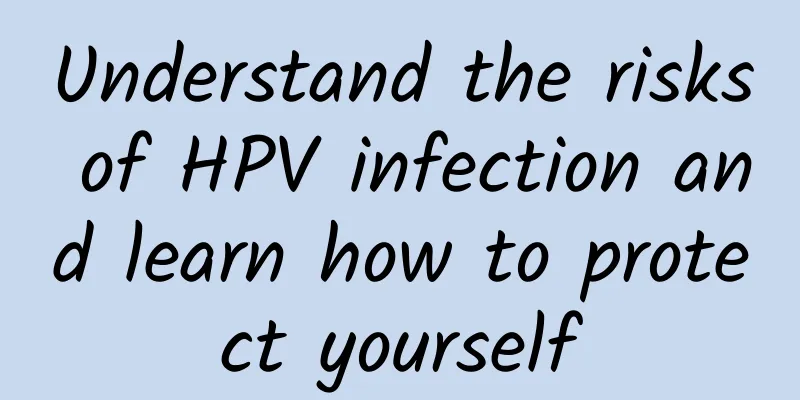Understand the risks of HPV infection and learn how to protect yourself

|
Author: Qi Shuzhen, Chief Physician, Dermatology Hospital, Chinese Academy of Medical Sciences (Institute of Dermatology, Chinese Academy of Medical Sciences) Reviewer: Jiang Juan, Researcher, Dermatology Hospital, Chinese Academy of Medical Sciences (Institute of Dermatology, Chinese Academy of Medical Sciences) In clinical practice, patients often become anxious and worried about cervical cancer due to infection with human papillomavirus (HPV). In fact, HPV infection does not necessarily lead to cancer. At present, about 200 types of HPV have been identified from the human body. According to the main infection site, they are divided into skin type and mucosal type; according to the carcinogenic potential, they are divided into low-risk type and high-risk type. Low-risk HPV mainly causes genital warts and some other benign lesions (such as common warts, recurrent respiratory papilloma, etc.), of which 90% of genital warts are caused by low-risk HPV6/11. Figure 1 Copyright image, no permission to reprint 1. High-risk HPV High-risk HPV mainly includes: 16/18/31/33/35/39/45/51/52/56/58/59/68 and other types. Most high-risk HPV infections are asymptomatic transient infections, which can be manifested histologically as low-grade squamous intraepithelial lesions of the cervix, that is, the pathology report shows mild cervical intraepithelial neoplasia, referred to as CIN1. More than 80% of CIN1 patients with HPV infection can be cleared by the body within 6 to 24 months. If the infection persists, it will progress to high-grade squamous intraepithelial lesions, which is what we see in clinical pathology reports showing moderate cervical intraepithelial neoplasia and severe cervical intraepithelial neoplasia, referred to as CIN2/CIN3. More than 60% of CIN1 patients will get better naturally, about 10% of CIN1 patients can develop into CIN2/CIN3 in 2 to 4 years, about 1% of CIN1 can progress to cervical cancer, and less than 50% of CIN3 patients can progress to invasive cervical cancer. The time from HPV infection to cervical cancer varies. Usually, HPV infection may develop into cancer after 10 to 20 years of continuous infection. In other words, most HPV infections will be cleared by the body, and only a few patients will continue to be infected and eventually develop into cervical precancerous lesions and invasive cancer. The results released by the International Agency for Research on Cancer (IARC) show that in 2020, it is estimated that more than 600,000 women worldwide will have new cervical cancer and more than 340,000 women will die from cervical cancer; among them, there are nearly 110,000 new cases of cervical cancer in my country and nearly 60,000 deaths. Cervical cancer has become a public health issue that seriously threatens women's health. Figure 2 Copyright image, no permission to reprint 2. Transmission routes of HPV The sources of HPV infection are patients and virus-infected persons, especially those whose genital skin or mucous membranes contain HPV viruses, which can be transmitted to spouses or sexual partners through sexual contact, and can also be transmitted among homosexuals. The main transmission routes of HPV are: ① Sexual transmission: This is also the main transmission route. Mucous membrane contact during homosexual or heterosexual sexual behavior can cause infection. ② Mother-to-child transmission: It is common for mothers with HPV infection in the reproductive tract to transmit it to newborns during delivery. For example, recurrent papilloma of the respiratory tract in children may be caused by fetal infection with HPV6/11 in vaginal secretions during delivery. ③ Skin and mucous membrane contact transmission: In addition to the cervix, HPV can also infect other parts of the body, such as the mouth, throat, skin and anus, and induce corresponding tumors. Figure 3 Copyright image, no permission to reprint 3. Risk factors that promote persistent HPV infection and progression to cervical cancer The risk factors that cause persistent HPV infection and progression to cervical cancer can be summarized into two main categories: one is biological factors, mainly including infections from various microorganisms such as bacteria, viruses and chlamydia, such as human immunodeficiency virus (HIV), Chlamydia trachomatis and gonococcal infections. These infections can destroy the local immune barrier and increase susceptibility, so these infections cooperate with each other and are "in cahoots" with each other; the second is behavioral risk factors: mainly including premature sexual activity, multiple sexual partners, multiple pregnancies, multiple births, smoking, long-term oral contraceptives, malnutrition, lack of health awareness, unwillingness to actively accept cervical cancer screening, and unwillingness to actively undergo screening due to high-risk sexual behaviors. |
<<: Afraid of gastroscopy? Learn in advance and eliminate your fear!
>>: Is melatonin a “magic drug” for insomnia?
Recommend
MAGNA: The Real Reddit
To better reach audiences, advertisers are upping...
Women always want to urinate but only urinate a little
Urine is also a way for the human body to detoxif...
Pain in left side of genitals
The vagina is particularly important for women. I...
What items does TCT inspection include?
The cervix is a very important part of women, m...
Is it harmful to human health to grow hibiscus indoors? How to grow hibiscus to make it bloom vigorously?
Hibiscus is very common in our daily life. People...
What to do if amniocentesis is high risk?
For female friends who are pregnant or have been ...
How to calculate the length of the menstrual cycle
What is the menstrual cycle table? Menstrual peri...
If there is a lot of foam in the urine, does it really mean that my kidneys are not in good condition?
gossip "Excessive foam in urine indicates ki...
What to do if you have low blood pressure and dizziness during breastfeeding
Low blood pressure is a common disease in our dai...
What causes dry lips during menstruation?
Dry lips are very common in life. Not only do man...
Can still express milk after four months of weaning
I believe every mother wants to feed her baby her...
Why is it difficult to get pregnant with hypothyroidism?
Hypothyroidism is a disease that occurs in both m...
What does it mean when a doctor asks me to do a molybdenum target?
Some people were found to have hyperplasia on the...
How to delay the onset of menopause?
Because some women experience menopause very aggr...
What is the principle of moxibustion treatment? What is the principle of moxibustion?
The near-infrared radiation of moxibustion provid...









